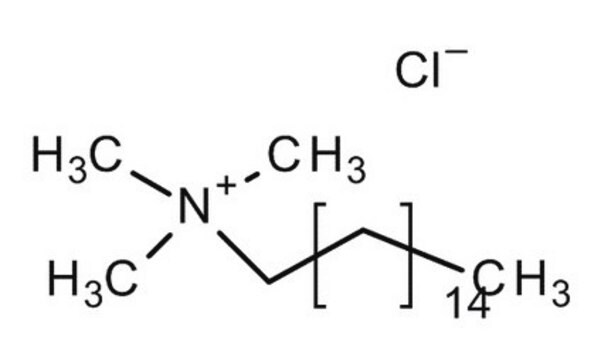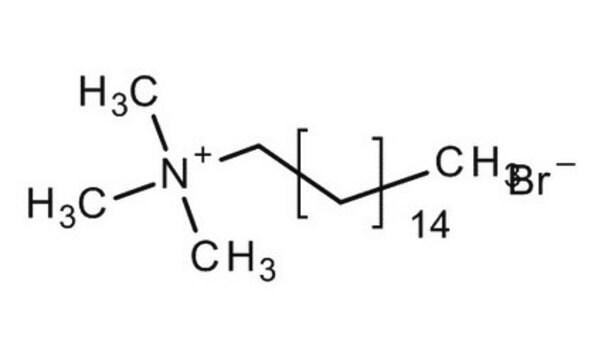52366
Hexadecyltrimethylammonium chloride
≥98.0% (NT)
Synonym(s):
Cetyltrimethylammonium chloride
About This Item
Recommended Products
description
cationic
Quality Level
Assay
≥98.0% (NT)
mol wt
320.00 g/mol
mp
232-237 °C
SMILES string
[Cl-].CCCCCCCCCCCCCCCC[N+](C)(C)C
InChI
1S/C19H42N.ClH/c1-5-6-7-8-9-10-11-12-13-14-15-16-17-18-19-20(2,3)4;/h5-19H2,1-4H3;1H/q+1;/p-1
InChI key
WOWHHFRSBJGXCM-UHFFFAOYSA-M
Application
- For the preparation of Polymethylsilsesquioxane aerogels (PMSQ) from methyltrimethoxysilane (MTMS) by hydrolysis and polycondensation reaction.
- To determine iodine and iodide in commercial gargle products by luminol chemiluminescence.
- As a template along with cetyltrimethylammonium bromide (CTAB) to prepare rod-like mesoporous silica from sodium silicate as a precursor.
- As a catalyst in the synthesis of 2-amino-2-chromenes from aldehyde, malononitrile, and phenol by one-pot three-component reaction.
Signal Word
Danger
Hazard Statements
Precautionary Statements
Hazard Classifications
Acute Tox. 3 Dermal - Acute Tox. 4 Oral - Aquatic Acute 1 - Aquatic Chronic 1 - Skin Corr. 1C
Storage Class Code
6.1D - Non-combustible acute toxic Cat.3 / toxic hazardous materials or hazardous materials causing chronic effects
WGK
WGK 3
Flash Point(F)
Not applicable
Flash Point(C)
Not applicable
Personal Protective Equipment
Regulatory Listings
Regulatory Listings are mainly provided for chemical products. Only limited information can be provided here for non-chemical products. No entry means none of the components are listed. It is the user’s obligation to ensure the safe and legal use of the product.
PRTR
Class I Designated Chemical Substances
ISHL Indicated Name
Substances Subject to be Indicated Names
ISHL Notified Names
Substances Subject to be Notified Names
JAN Code
52366-50G:
52366-10G:
52366-INTR:
52366-BULK:
52366-VAR:
Choose from one of the most recent versions:
Already Own This Product?
Find documentation for the products that you have recently purchased in the Document Library.
Customers Also Viewed
Our team of scientists has experience in all areas of research including Life Science, Material Science, Chemical Synthesis, Chromatography, Analytical and many others.
Contact Technical Service














